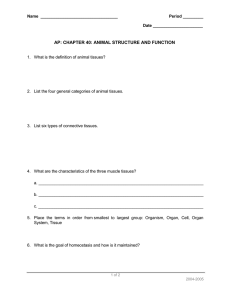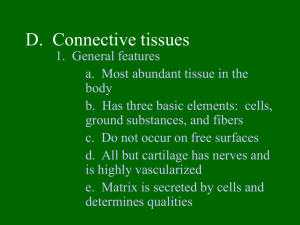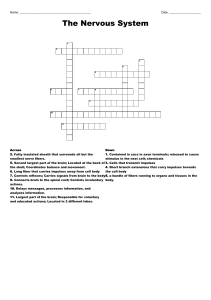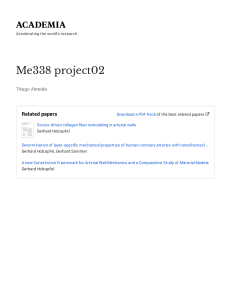Lecture #18 Date _______ Chapter 40 ~ An Introduction to
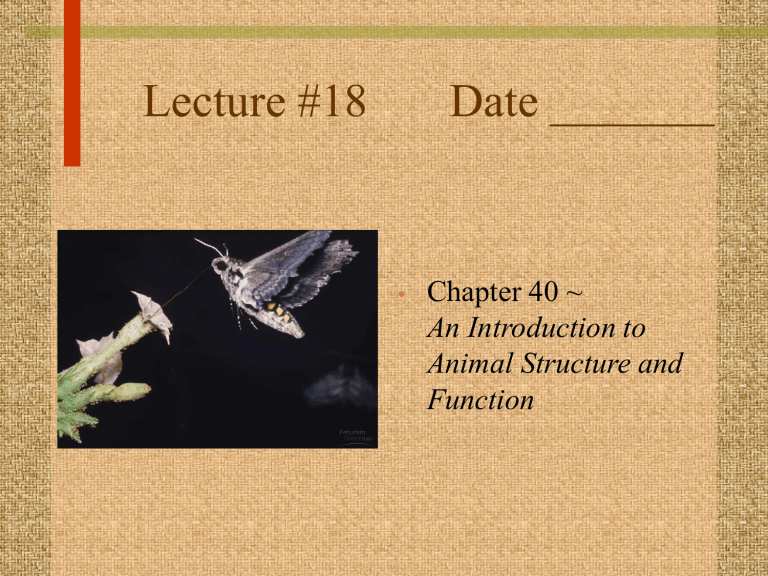
Lecture #18 Date _______
• Chapter 40 ~
An Introduction to
Animal Structure and
Function
•
•
•
•
•
•
•
•
•
•
Tissues : groups of cells with a common structure and function (4 types)
Anatomy : structure
Physiology : function
1- Epithelial: outside of body and lines organs and cavities; held together by tight junctions basement membrane : dense mat of extracellular matrix
Simple: single layer of cells
Stratified: multiple tiers of cells
Cuboidal (like dice)
Columnar (like bricks on end)
Squamous (like floor tiles) mucous membrane
•
•
•
•
•
•
•
•
•
Tissues, II
2- Connective: bind and support other tissues; scattered cells through matrix; 3 kinds:
A-Collagenous fibers (collagen protein) B-Elastic fibers (elastin protein) C-Reticular fibers (thin branched collagen fibers)
Loose connective tissue: binds epithelia to underlying tissue; holds organs
1-Fibroblasts- secretes extracellular proteins 2-Macrophages- amoeboid WBC’s; phagocytosis 3-
Adipose tissue- fat storage; insulation
Fibrous connective tissue: parallel bundles of cells
1-Tendons- muscles to bones 2-Ligaments- bones to bones; joints ( BOBOL I)
Cartilage: collagen in a rubbery matrix ( chondroitin ); flexible support
Bone: mineralized tissue by osteoblasts
Blood: liquid plasma matrix; erythrocytes (RBC’s) carry O
2 ; leukocytes (WBC’s) immunity
Tissues, III
•
•
•
•
3-Nervous: senses stimuli and transmits signals from
1 part of the animal to another
Neuron : functional unit that transmits impulses
Dendrites : transmit impulses from tips to rest of neuron
Axons : transmit impulses toward another neuron or effector
Tissues, IV
•
•
•
•
4- Muscle: capable of contracting when stimulated by nerve impulses; myofibrils composed of proteins actin and myosin; 3 types:
ASkeletal : voluntary movement (striated)
BCardiac : contractile wall of heart (branched striated)
CSmooth : involuntary activities (no striations)
•
•
•
•
•
•
Organ: organization of tissues
Mesentaries: suspension of organs (connective tissue)
Thoracic cavity (lungs and heart)
Abdominal cavity
(intestines)
Diaphragm (respiration)
Organ systems…...
Organ systems
•
•
•
•
•
•
•
•
•
•
•
Digestive -food processing
Circulatory -internal distribution
Respiratory -gas exchange
Immune/Lymphatic -defense
Excretory -waste disposal; osmoregulation
Endocrine -coordination of body activities
Reproductive -reproduction
Nervous -detection of stimuli
Integumentary -protection
Skeletal -support; protection
Muscular -movement; locomotion
•
•
•
•
Internal regulation
Interstitial fluid : internal fluid environment of vertebrates; exchanges nutrients and wastes
Homeostasis : “steady state” or internal balance
Negative feedback : change in a physiological variable that is being monitored triggers a response that counteracts the initial fluctuation; i.e., body temperature
Positive feedback : physiological control mechanism in which a change in some variable triggers mechanisms that amplify the change; i.e., uterine contractions at childbirth
Metabolism : sum of all energyrequiring biochemical reactions
•
•
•
•
•
•
Catabolic processes of cellular respiration
Calorie; kilocalorie/C
Endotherms : bodies warmed by metabolic heat
Ectotherms : bodies warmed by environment
Basal Metabolic Rate (BMR): minimal rate powering basic functions of life (endotherms)
Standard Metabolic Rate
(SMR): minimal rate powering basic functions of life
(ectotherms)
